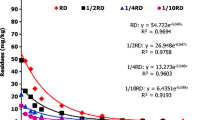Abstract
The analytical method for the residue analysis of a sulfonylurea herbicide, rimsulfuron, and its dissipation in soil and potato plants under field conditions were studied. Rimsulfuron residues were determined by Quick, Easy, Cheap, Effective, Rugged and Safe (QuEChERS) method and ultra-performance liquid chromatography coupled with tandem mass spectrometry (UPLC-MS/MS). Mean recoveries ranged from 74.6 % to 106.2 % with relative standard deviations (RSDs) of 2.0 %–13.8 % at three different spiking levels for each different matrix. The limits of detection (LOD) of rimsulfuron were ranged from 0.3 to 1.4 μg/kg, while the limits of quantification (LOQ) ranged from 0.9 to 4.3 μg/kg in different matrixes. The dissipation dynamics of rimsulfuron in the field trials in Shandong and Zhejiang Province were investigated. The half-lives in potato seedlings were 4.1 days in Shandong and 4.3 days in Zhejiang, both with a dissipation rate of 90 % about 7 days after application. The half-lives in soil were 6.0 days in Shandong and 6.6 days in Zhejiang, and with a dissipation rate of 90 % over 28 days. The terminal residues in potato and soil were not detectable. The fact that all the terminal residues were below the maximum residue level (0.1 mg/kg) set by Japan and 0.05 mg/kg set by EU. Hence it was safe for the use of this pesticide and the results also could give a reference for maximum residue limits setting of rimsulfuron in potato in China.
Similar content being viewed by others
References
Annette ER, Jeanne K, Preben O (2010) Long-term leaching of rimsulfuron degradation products through sandy agricultural soils. Chemosphere 79:830–838
Cheryl AP, Robert MH, Thomas CM (2002) Dissipation of nicosulfuron and rimsulfuron in surface soil. J Agric Food Chem 50:4581–4585
Dani D, Allan JC, Renata R, Dan JP (2010) Trace level determination of selected sulfonylurea herbicides in wetland sediment by liquid chromatography electrospray tandem mass spectrometry. J Environ Sci Health B 45:11–24
Haidar MA, Sidahmed MM, Darwish R, Lafta A (2005) Selective control of Orbanche ramose in potato with rimsulfuron and sub-lethal doses of glyphosate. Crop Prot 24:743–747
Huang SZ, Li ZX, Ling LY, Liu XW, Huang YC (2002) Residual dynamic of rimsulfuron (DPX-E9636) in corn and soil. Agro-Environ Prot 21(4):343–345
Jean MFM, Andre M (1999) Transport of rimsulfuron and its metabolites in soil columns. Chemosphere 38(3):601–616
Laura S, Sabino AB, Piero P, Pierre M, Mohammed M (1999) Photolysis and hydrolysis of rimsulfuron. Pestic Sci 55:955–961
Li XX, J YP, Shan WL, Pan CP (2010) Dissipation and residues detection of dioctyldiethylenetriamine acetate in rice plant and environment by QuEChERS method and liquid chromatography/electrospray tandem mass spectrometry. Bull Environ Contam Toxicol 84:596–601
Liu XG, Xu J, Dong FS, Li YB, Song WC, Zheng YQ (2011) Residue analysis of four diacylhydrazine insecticides in fruits and vegetables by Quick, Easy, Cheap, Effective, Rugged, and Safe (QuEChERS) method using ultra-performance liquid chromatography coupled to tandem mass spectrometry. Anal Bioanal Chem 401:1051–1058
Lu XT, Zhang TT, Zhang Y, Kong FH, Ma WY, Ma SZ, Zhang CL (2011) Weed control efficacy and potato safety of rimsulfuron. Agrochemicals 50(11):845–847
Polati S, Bottaro M, Frascarolo P, Gosetti F, Gianotti V, Gennaro MC (2006) HPLC-UV and HPLC-MSn multiresidue determination of amidosulfuron, azimsulfuron, nicosulfuron, rimsulfuron, thifensulfuron methyl, tribenuron methyl and azoxystrobin in surface waters. Anal Chim Acta 579:146–151
Vischetti C, Perucci P, Scarponi L (2000) Relationship between rimsulfuron degradation and microbial biomass content in a clay loam soil. Biol Fertil Soils 31:310–314
Wang J, Zhao LL, Li XX, Jiang YP, Li N, Qin ZH, Pan CP (2011) Residue dynamic of pyrimorph on tomatoes, cucumbers and soil under greenhouse trials. Bull Environ Contam Toxicol 86:326–330
Acknowledgments
This work was supported by Technology New Star Program of Beijing (2011099), Public service sector R & D Project (200903033) and National Natural Science Foundation of China (30900951, 31201528).
Author information
Authors and Affiliations
Corresponding author
Additional information
Yanbing Wu and Xingang Liu contributed equally to this study.
Rights and permissions
About this article
Cite this article
Wu, Y., Liu, X., Dong, F. et al. Dissipation and Residues of Rimsulfuron in Potato and Soil Under Field Conditions. Bull Environ Contam Toxicol 89, 1264–1267 (2012). https://doi.org/10.1007/s00128-012-0850-1
Received:
Accepted:
Published:
Issue Date:
DOI: https://doi.org/10.1007/s00128-012-0850-1




